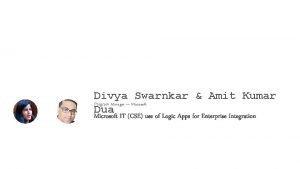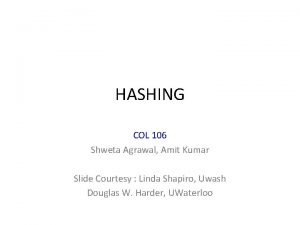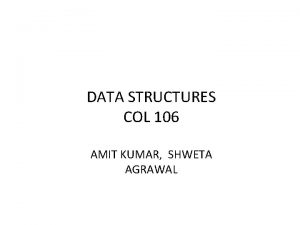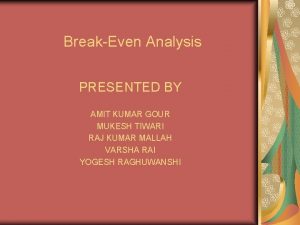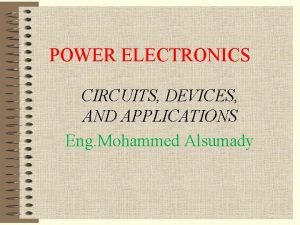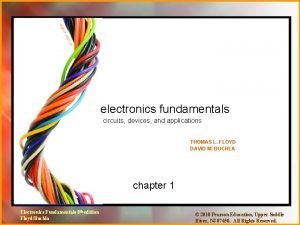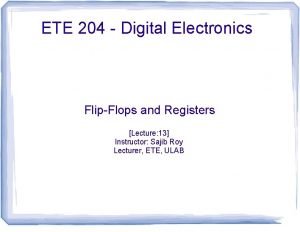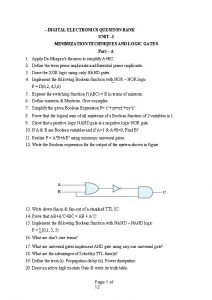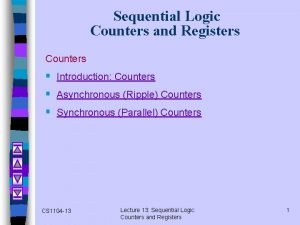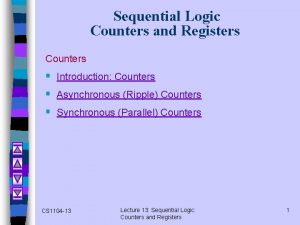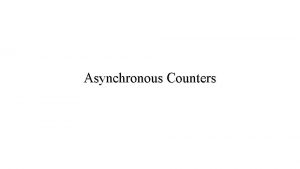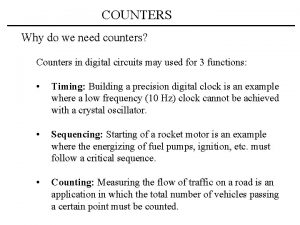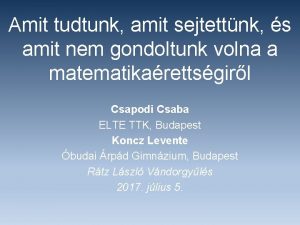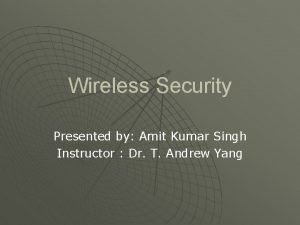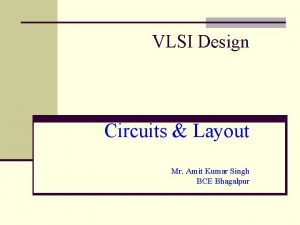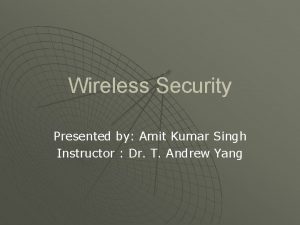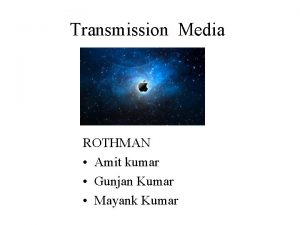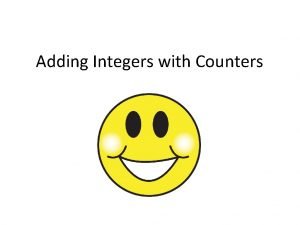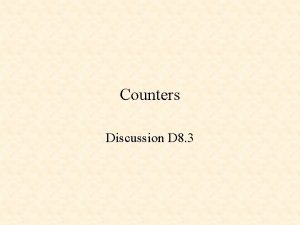Digital Electronics Principles Applications Amit Kumar Singh Counters














- Slides: 14

Digital Electronics Principles & Applications Amit Kumar Singh Counters

CHAPTER 8 PREVIEW • • • Overview of Counters Characteristics of Counters Ripple Up Counter Ripple Counter with Waveforms Ripple Down Counter Self-stopping Counter Frequency Division using Counters Using Counter ICs Magnitude Comparators Troubleshooting Equipment Troubleshooting Hints

OVERVIEW OF COUNTERS • Counter-by definition – One input (clock) – Outputs follow defined sequence • Common tasks of counter – Count up or down – Increment or decrement count – Sequence events – Divide frequency – Address memory – As memory

CHARACTERISTICS OF COUNTERS • Number of bits (4 -bit, 8 -bit, etc. ) • Maximum count – 4 bit = 24 = 0000 to 1111 in binary – 8 bit = 28 = 0000 to 1111 in binary • Modulus of counter-number of states – Decade counter – 4 -bit – 8 -bit • Up or down counter • Asynchronous or synchronous counter • Presettable counter • Self-stopping counter

RIPPLE COUNTER Binary Output Clock Input 00 1 10 10 1 Pulse 8 1 2 3 4 5 6 7 PS CLR input All 16 J-K flip-flops This Onand the 4 -bit next counter clockhas pulse (8) states all FFs and are in the will count toggle from because binary each 0000 will through receive 1111 INACTIVE TOGGLE MODE a H-to-L and then pulsereset one back after to another. 0000. Watch Thethe counter counthas ripple a modulus thru theof counter. 16.

RIPPLE COUNTER WITH WAVEFORMS Binary Output Clock Input 01 00 10 1 Pulse 5 1 2 3 4 Clock input FFs triggered on 1 s output H-to-L pulse. CLK toggles 1 s FF toggles 2 s FF. 2 s output 2 s FF toggles 4 s FF. 4 s output

DECADE COUNTER Binary Output Clock Input 111 ial c t i n I t 0 nt a ou 11 0 00 11 0 Pulse 8 1 2 3 4 5 6 7 Short negative pulse To clear input of each FF All J & K inputs = 1 All PR inputs = 1 To change mod-16 counter to decade counter: Count is at 1001. Reset count to 0000 after 1001 (9) count. Next clock pulse will increment counter for a When count hits 1010 reset to 0000. short time to 1010 which will activate the NAND gate See added 2 -input NAND gate that clears all and reset the counter to 0000. JK FFs to 0 when count hits 1010.

DOWN COUNTER 11 0 00 1 4 2 1 Pulse 5 3 Changes from Ripple Up Counter are wiring from Q’ outputs (instead of Q outputs) to the CLK input of the next FF. t oun c l a i Init t at se 111 y r a bin

SELF-STOPPING DOWN COUNTER 10 0 10 1 unt on tch coremained The Wacount. Pulse 8000. at binary 2 3 4 Pulse 8 1 5 6 7 This is a 3 -bit down counter. The 1 s FF is in TOGGLE mode when counting (J & K = 1). The 1 s FF switches to HOLD mode when the J and K inputs are forced LOW by the OR gate when the count decrements to 000. The count stops at 000.

COUNTER USED FOR FREQUENCY DIVISION 8 100 Hz 50 Hz 16 Clock Input 800 Hz 200 Hz 4 400 Hz 2

USING THE 7493 COUNTER IC • Counters are available in IC form. • Either ripple (7493 IC) or synchronous (74192 IC) counters are available. 100 ? Hz Hz 400 ? Hz Hz ? Hz 800 Hz 1600 Hz 7493 Counter IC wired as a 4 -bit binary counter

MAGNITUDE COMPARATOR A magnitude comparator is a combinational logic device that compares the value of two binary numbers and responds with one of three outputs (A=B or A>B or A<B). A(0) A(1) Inputbinary 0111 1111 0001 A(2) 74 HC 85 Magnitude Comparator A(3) B(0) B(1) Input binary 0110 0111 1100 B(2) B(3) A>B HIGH A=B HIGH A<B HIGH

TROUBLESHOOTING EQUIPMENT • • Logic Probe Logic Pulser Logic Clip (logic monitor) Digital IC Tester DMM/Logic Probe DMM or VOM Dual-trace Oscilloscope Logic Analyzer

SIMPLE TROUBLESHOOTING HINTS • Feel top of IC to determine if it is hot • Look for broken connections, signs of excessive heat • Smell for overheating • Check power source • Trace path of logic through circuit • Know the normal operation of the circuit
 Asynchronous counter d flip flop
Asynchronous counter d flip flop Amit kumar microsoft
Amit kumar microsoft Col 106
Col 106 Col 106 amit kumar
Col 106 amit kumar Col 106 amit kumar
Col 106 amit kumar Col 106 amit kumar
Col 106 amit kumar Sarwan singh kundan singh
Sarwan singh kundan singh Heat pipes for electronics cooling applications
Heat pipes for electronics cooling applications Power electronics circuits devices and applications
Power electronics circuits devices and applications Electronics fundamentals circuits devices and applications
Electronics fundamentals circuits devices and applications A digital camera is an electronic device used to capture
A digital camera is an electronic device used to capture Setup time and hold time in digital electronics
Setup time and hold time in digital electronics Ete
Ete Whats an analog
Whats an analog Digital electronics question bank
Digital electronics question bank

